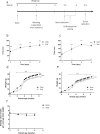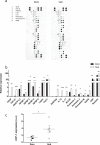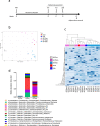Gut microbiota determines the social behavior of mice and induces metabolic and inflammatory changes in their adipose tissue
- PMID: 33741982
- PMCID: PMC7979825
- DOI: 10.1038/s41522-021-00193-9
Gut microbiota determines the social behavior of mice and induces metabolic and inflammatory changes in their adipose tissue
Abstract
The link between the gut microbiota and social behavior has been demonstrated, however the translational impact of a certain microbiota composition on stable behavioral patterns is yet to be elucidated. Here we employed an established social behavior mouse model of dominance (Dom) or submissiveness (Sub). A comprehensive 16S rRNA gene sequence analysis of Dom and Sub mice revealed a significantly different gut microbiota composition that clearly distinguishes between the two behavioral modes. Sub mice gut microbiota is significantly less diverse than that of Dom mice, and their taxa composition uniquely comprised the genera Mycoplasma and Anaeroplasma of the Tenericutes phylum, in addition to the Rikenellaceae and Clostridiaceae families. Conversely, the gut microbiota of Dom mice includes the genus Prevotella of the Bacteriodetes phylum, significantly less abundant in Sub mice. In addition, Sub mice show lower body weight from the age of 2 weeks and throughout their life span, accompanied with lower epididymis white adipose tissue (eWAT) mass and smaller adipocytes together with substantially elevated expression of inflammation and metabolic-related eWAT adipokines. Finally, fecal microbiota transplantation into germ-free mice show that Sub-transplanted mice acquired Sub microbiota and adopted their behavioral and physiological features, including depressive-like and anti-social behaviors alongside reduced eWAT mass, smaller adipocytes, and a Sub-like eWAT adipokine profile. Our findings demonstrate the critical role of the gut microbiome in determining dominance vs. submissiveness and suggest an association between gut microbiota, the eWAT metabolic and inflammatory profile, and the social behavior mode.
Conflict of interest statement
The authors declare no competing interests.
Figures









Similar articles
-
Colon impairments and inflammation driven by an altered gut microbiota leads to social behavior deficits rescued by hyaluronic acid and celecoxib.BMC Med. 2024 Apr 29;22(1):182. doi: 10.1186/s12916-024-03323-0. BMC Med. 2024. PMID: 38685001 Free PMC article.
-
Abnormal gut microbiota composition is associated with experimental autoimmune prostatitis-induced depressive-like behaviors in mice.Prostate. 2020 Jun;80(9):663-673. doi: 10.1002/pros.23978. Epub 2020 Apr 7. Prostate. 2020. PMID: 32255522
-
Variations in gut microbiota and fecal metabolic phenotype associated with depression by 16S rRNA gene sequencing and LC/MS-based metabolomics.J Pharm Biomed Anal. 2017 May 10;138:231-239. doi: 10.1016/j.jpba.2017.02.008. Epub 2017 Feb 10. J Pharm Biomed Anal. 2017. PMID: 28219800
-
Questioning the foundations of the gut microbiota and obesity.Philos Trans R Soc Lond B Biol Sci. 2023 Oct 23;378(1888):20220221. doi: 10.1098/rstb.2022.0221. Epub 2023 Sep 4. Philos Trans R Soc Lond B Biol Sci. 2023. PMID: 37661739 Free PMC article. Review.
-
Interplay between gut symbionts and behavioral variation in social insects.Curr Opin Insect Sci. 2024 Oct;65:101233. doi: 10.1016/j.cois.2024.101233. Epub 2024 Jul 15. Curr Opin Insect Sci. 2024. PMID: 39019113 Review.
Cited by
-
Antibiotic-induced socio-sexual behavioral deficits are reversed via cecal microbiota transplantation but not androgen treatment.Brain Behav Immun Health. 2023 May 18;30:100637. doi: 10.1016/j.bbih.2023.100637. eCollection 2023 Jul. Brain Behav Immun Health. 2023. PMID: 37256194 Free PMC article.
-
The Role of Gut Microbiota in the Skeletal Muscle Development and Fat Deposition in Pigs.Antibiotics (Basel). 2022 Jun 11;11(6):793. doi: 10.3390/antibiotics11060793. Antibiotics (Basel). 2022. PMID: 35740199 Free PMC article.
-
Connection of pre-competition anxiety with gut microbiota and metabolites in wrestlers with varying sports performances based on brain-gut axis theory.BMC Microbiol. 2024 Apr 27;24(1):147. doi: 10.1186/s12866-024-03279-4. BMC Microbiol. 2024. PMID: 38678197 Free PMC article.
-
Royal Jelly Enhances the Social Status of Submissive Rats by Restoring Balance to the Disturbed Gut-Brain Communication.Foods. 2025 Feb 27;14(5):819. doi: 10.3390/foods14050819. Foods. 2025. PMID: 40077522 Free PMC article.
-
MetaPhlAn 4 profiling of unknown species-level genome bins improves the characterization of diet-associated microbiome changes in mice.Cell Rep. 2023 May 30;42(5):112464. doi: 10.1016/j.celrep.2023.112464. Epub 2023 May 3. Cell Rep. 2023. PMID: 37141097 Free PMC article.
References
-
- Bouter, K. E., Raalte, D. H. van, Groen, A. K. & Nieuwdorp, M. Role of the gut microbiome in the pathogenesis of obesity and obesity-related metabolic dysfunction. Gastroenterology152, 1671–1678 (2017). - PubMed
-
- Donovan SM. Introduction to the special focus issue on the impact of diet on gut microbiota composition and function and future opportunities for nutritional modulation of the gut microbiome to improve human health. Gut Microbes. 2017;8:75–81. doi: 10.1080/19490976.2017.1299309. - DOI - PMC - PubMed
Publication types
MeSH terms
Substances
LinkOut - more resources
Full Text Sources
Other Literature Sources
Medical

